I have been back from my Maasai home stay for two days now and I am still struggling to write about it. I could variously describe the experience as appalling, fascinating, stimulating, exhausting, rewarding, frustrating, mind-expanding, enraging, or gratifying, and each one of those adjectives would be appropriate. But, let me start at the beginning.

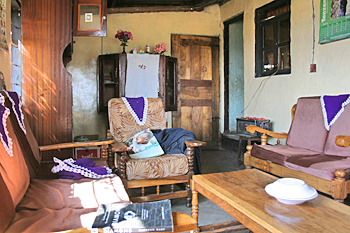
My host, Morani Poyoni, picked me up in his older model Land Rover and drove me the nine kilometers to his house, located high in the hills above the town of Monduli. Morani and his wife, Sara, are among the few Maasai who have adopted western ways and left the traditional village. Both pursued educations and became teachers. Sara still teaches at the local primary school but these days Morani concentrates on his home stay program, which can include anything from allowing two dozen British teenagers to camp in his backyard while preparing for a climb of Mount Kilimanjaro to planning intensive multi-day programs for people like me who want to learn more about the Maasai culture.
I scheduled this cultural home stay with some romantic notion that I could discover the true Maasai way of life, meet with Maasai elders, and learn from the village healers. I accomplished all those goals, but I was totally unprepared for much of what I learned. Maasai is a patriarchal and hierarchical society. The women do all the work but have none of the power. Among other duties, they prepare the food, clean, wash the clothes, rear the children, construct the huts, gather and carry the firewood, carry the water, do the marketing, and tend the fire. The men spend most of their day lying about or socializing, as they are responsible only for protection of the family and caring for the massive herds of cattle, goat, and sheep that every Maasai man must maintain, since the number of cattle that a man owns determines his wealth and his status in the tribe. As Morani said, “No cattle, no respect.”
Children are seen a chattel. Girls are tolerated because they will fetch a dowry of 25 cattle for their fathers when they are married off at age 15 and boys are useful because they take over the job of herding the livestock as soon as they are old enough. Indeed, a Maasai cares more for his cattle than his children; he will walk many miles to get medicine for a sick cow but will not do the same for his child.
The village we visited on my first day consisted of 58 huts that were all owned by one man – one hut for each of his 58 wives. Every new wife, along with her friends and family members, must build a hut (like the one under construction in the photo below), which then becomes the property of the husband. The Maasai live communally and are obliged to welcome any other member of the tribe into their hut, regardless of how many arrive or how long they intend to stay. It is also common for wives to be shared by the men – there is no jealousy among the Maasai.
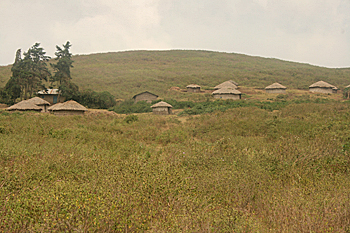
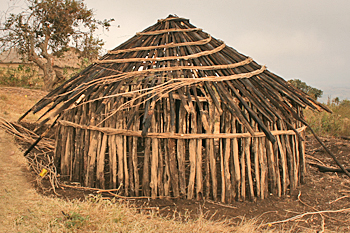
On this particular morning the village midwife, Molelliani, welcomed me into ‘her’ hut. We sat around a smoldering fire of acacia twigs piled in the center of the domed hut. As my eyes adjusted to the smoky darkness, I saw four doorways radiating from the center: a communal sleeping room for the women and another for the men, both fitted with raised dirt floors covered with a thin cowhide; a storage room; and a room where young calves can be housed in cold weather. In this hut, Molelliani delivers up to 50 babies per year, allowing each expectant mother to move into her hut for the last two months of her pregnancy. For this she receives no compensation, although her position allows her to order the young warriors to bring her food or gather herbs necessary for her profession.
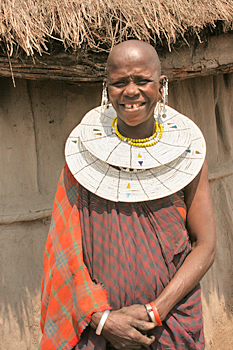
The fact that any Maasai baby could be born healthy is testament to our ability as humans to adapt to almost anything. In this village the winds blow ceaselessly, kicking up a fine grey dust that coats everything. On their feet the Maasai wear sandals made from old tires. Their dusty toes poke out from the recycled treads; black grit is embedded under their toenails. They wear colorful red, blue and purple blankets around their torsos, draping the extra lengths of fabric over their shoulders. When Molelliani pulled aside her upper blanket to point to her abdomen she exposed her naked breasts – I was amazed that she was wearing nothing under her blanket, despite the bitter cold winter temperatures. The multitude of children hanging around the hut were covered in grime, with snot pouring from their noses and flies embedded in the gunk collecting under their eyes. The Maasai eat only meat, blood and milk and in most cases the children are lucky if they get two meals a day, consisting only of milk.
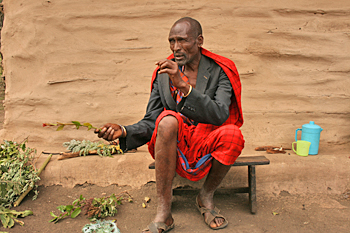
On day two I was honored to meet with the village herbal man. Morani and I walked the several kilometers to his home, where I was received in the front yard. He wore the traditional Maasai blankets, covered by a western suit jacket. After introductions he gathered his red blankets about him and slowly sank onto a low wooden bench surrounded by heaps of roots, bark, and branches. With years of experience and knowledge at his disposal, he diagnoses and treats diseases and ailments, using only these local natural plants and herbs. One of his concoctions treats joint problems – two cups of liquid in which a certain red tree bark has been steeped cures arthritis. The flower of another plant cures malaria. Tiny quantities of liquid from the fruit of the Sodom Apple, mixed with cattle fat, cures pneumonia. The seeds of the Elodua Tree are ground up and boiled with milk or water, the resultant liquid drunk like coffee to purge the system of roundworms. The herbalist knows the treatment is working because the patient’s urine turns purple. Several of his treatments deal with sexual dysfunction – indeed when I asked what is the most common ailment among tribe members he answered that the bulk of his treatments are for fever and sexual dysfunction.
There is a wealth of untapped knowledge here that could have applications for modern medicine. Most people don’t realize that many of our modern drugs are based in natural plants – aspirin, for instance, originated from the bark of the willow tree. Of course, today aspirin is synthetic – the chemical properties of the willow have been replicated in the lab – but this could never have been accomplished without initially studying the willow. I worry that this valuable information will be lost as the Maasai adopt modern ways, but the herbal man has a young apprentice, so this knowledge is sure to be preserved for at least another generation.
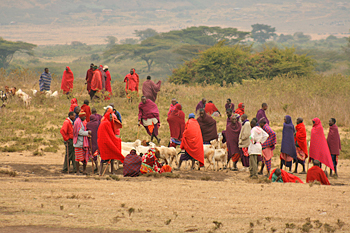
My final day fell on the day of the Red Market in town, so named because everyone wears red. Here the Maasai gather every Sunday afternoon to sell livestock and purchase supplies for the next week. For hours before the market began, scores of young Maasai men walked down the mountain roads to the village, dragging goats and sheep to be slaughtered or sold. Maasai women balanced enormous bags full of beans, rice, or corn on their heads as they trod the dusty road. At 2 PM we walked to town and joined the throngs at the market. The livestock was being offered for sale on the right side of the road. Men pinched the rumps of the goats to see if they were plump and prized apart their jaws to inspect their teeth. The sheep and goats strained at their tethers, as if they knew their fate. One pair of goats, tied together with a short strip of blue cloth, wandered in circles, unable to cooperate enough to walk a straight line to escape.
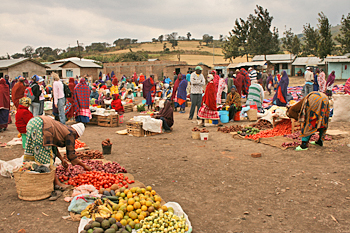
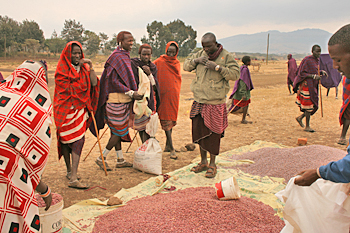

On the right side of the road hundreds of vendors stood or sat on large tarps aside the products they offered for sale. In addition to the grains I saw fresh fruits and vegetables, stationery supplies, clothing, cookware, tires, and tools – almost anything one could want. To the rear of the village men butchered live sheep and goat that were hung from a wooden frame, the blood from their slit throats spilling onto the ground. Large skewered sides of meat roasted over an open fire, their dripping fat sizzling as it hit the flames. My guide for the day, Jackson, selected a slab of goat that was nearly done and we carried it back up the road in a plastic bag. Back home five unexpected guests arrived for dinner and the roasted goat was set out on a tray on the living room coffee table. Two of the visiting Maasai elders sitting on opposite side of the coffee table grabbed the slab of meat, holding it between them, high above the table. One of them deftly unsheathed his long knife and carved the goat into bite-sized pieces, dropping them onto the tray beneath, with an occasional diversion of a chunk into his own mouth. Everyone (except for me) helped themselves to the meaty finger food.

Many visitors come to see Morani because has been elected a village leader and as such he is regularly consulted about tribal issues and problems. This in itself is a sign that things are changing – Morani owns no cattle, yet the tribe has come to respect him enough to place him in a high position. From his status as village leader, as well as his position as a member of the school board, he is working to effect change within the tribe. Morani and Sara realize that education is the key to change. Unfortunately, Maasai elders resist sending their children to school, fearing that the children will leave tribal life once they are educated. Unable to convince the elders, Morani is attacking the problem from the opposite direction – he uses some of the proceeds from his tour business to provide lunches for the four pre-schools in his district, believing that the children will WANT to come to school if they are assured at least one good meal per day. The program is working. Sara now struggles each day to stretch the school’s limited resources to serve the 70+ students in each of her classes.
The more children that can be channeled through the educational system, the better the chances that some of the barbaric customs of the Maasai will be discontinued. At the age of 15, Maasai boys undergo a circumcision ceremony, after which they are considered to be junior warriors. Sadly, the girls are also circumcised at age 15, removing the flap of skin that covers the clitoris and condemning them to a life of excruciating pain whenever they have intercourse. The government of Tanzania is trying to ban this practice, although in the short term their attempts have backfired. In some instances tribal elders are circumcising girls as young as age five for fear that they will be prohibited from performing the ceremony in the future.
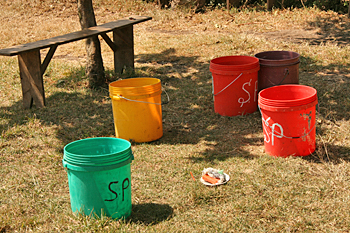
Sara is convinced that change will come, but it will come slowly. I have great admiration for Sara and Morani, who are determined to make a difference despite facing great adversity of their own. Although they own a parcel of land and have built a house, they have no running water, heat, or indoor plumbing. Until recently, they had electricity from a solar panel but this has been disconnected in preparation for a connection from the local electrical company. The electric service was promised two weeks ago and Morani checks with the company every day – each time he is told it will be connected tomorrow. For the moment the only light is from kerosene lanterns. The bathrooms are twin squat toilets in outhouses located on the rear of the property. For water, Morani drives up the mountain to a communal tap at a primary school, filling five gallon buckets and carting them back home. Before he bought the Land Rover he transported the buckets by donkey. Dirty dishes are cleaned in the yard, using a bar of soap, a rag, and a series of five gallon buckets to soak, wash, and rinse the dishes. Because water is precious the used dishwater is saved to wash the outhouse floors every few days. Laundry is done by hand, scrubbing the clothes clean in a tub of cold soapy water in the backyard.
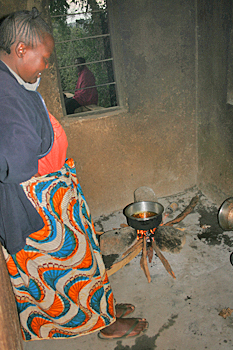
Even cooking is a monumental chore. On some days Sara bends over a wood fire she builds on the concrete floor of her kitchen, patiently stirring the pans as clouds of billowing smoke envelop her. Other days she cooks on a tiny hibachi grill on the front porch that she fires with chunks of charcoal made from the local acacia wood. I was constantly amazed that she was able to produce such elaborate, delicious meals, given the rudimentary conditions in which she operated.

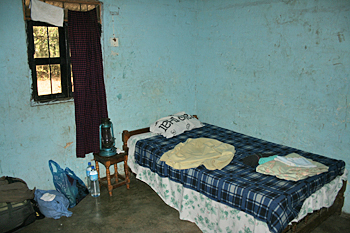
Although their lives are unbelievably hard I never once heard either Sara or Morani complain. They constantly worried over my comfort and needs, although they were suffering – while I was there both Morani and their two-year old daughter, Linda, developed bad coughs from sleeping in the freezing cold temperatures without heat. For myself, I was warm enough under the two sheets and warm blanket they provided, but I had a horrific thought the day I left. I desperately hope that they did not give me their only blanket for my bed. I already feel guilty that I have so much more than they do. If this trip has taught me anything it is to be grateful for everything I have and for everything that is available to us in America.

Hi Barbara,
Thank you for having shared your travel experience with the Maasai tribe. Your article is very well-written and informative.
I am wondering if the Poyoni family is still offering this tour. If you still have his contact (or give me advices on how to find a similar tour) it would be very helpful. The Maasai experience offered by the agencies look often disappointed.
Many thanks!
Hi Sarah: It’s been 11 years since I visited Tanzania, so I really don’t know if the Poyoni family is still hosting visitors. However, you may wish to contact the company I worked with, Safari Makers. I just checked and they are still in business, though the woman I worked with has since passed away. http://www.safarimakers.com/
Hiya Barbara and thanks for posting your Maasai Homestay experience of 2007 in the area of Monduli Juu and not far from the remote Maasai mountain village of Emeriti where the fascinating Red Market is still, in 2015, held weekly and where the Maasai Stoves and Solar project (www.internationalcollaborative.org) has just opened a corn flour mill (staffed by a rotation of Maasai women) in the market area not far from where the goats are slaughtered and roasted.
The Maasai Stoves and Solar project, an initiative begun by Professor Robert Lange of Boston about 4 years ago and whose onsite Manager is an efficient Maasai man (whose father has 78 wives!), named Kisioke Motoike, installs smokeless box stoves (so that the Maasai women can cook without all that toxic smoke constantly irritating their lungs and eyes and impairing their health!) and solar lights in the Maasai villages around Monduli and beyond, even to Kenya and Uganda. So far, they have placed smokeless box stoves and solar lights in 8 villages around Monduli and have just received a further funding from Adfa (the funding arm of the Seventh Day Adventists), to do so in 3 more villages, that is, about 300 more smokeless box stoves and solar lights will be able to be installed in Maasai bomas in the coming months.
My travel buddy and I (my travel buddy is a nurse and I a teacher) were fortunate to have been invited (when we expressed interest to him by email) by Professor Bob to visit some of the extremely beneficial and practical projects of this n.g.o. and were thus personally able to witness the benefits already being enjoyed as well as the excitement of the Maasai villagers at the meetings with the elders who were being invited to be selected as the next recipients of these ongoing projects!:)
As you would be able to learn on his site (www.internationalcollaborative.org), a newer version of the smokeless box stove has been able to incorporate an extra division for boiled water for tea-making as well as the new design being able to gain 4 stoves from the steel panel instead of just two, thus bringing the production costs down even further: currently 100 Australian dollars for both production and installation of the smokeless box stove and a solar light panel. From the point of view of empowerment of women, the Maasai women are taught to be the installers and are paid a small amount for this work, often the first income they have ever personally received. According to the funding available, Professor Bob and his team have also implemented the introduction of two corn flour mills thus far ( at a cost of $ 5,500 Australian dollars each), are hoping to implement more; have also electrified some villages thus enabling a small refrigerator and a computer to be installed; about a year ago, for further empowerment, have assisted the Maasai women to form themselves into an organisation called the Maasai Women’s Pastoralist Organization with more than 100 dues paying members who have already undertaken their first project of fattening 40 goats and 40 bulls and are hoping to undertake their 2nd project of building a concrete brick making factory which, given the rather prohibitive cost of U.S. $ 20,000 may take a while to achieve. Meanwhile, the ever industrious and practical Professor Bob is also working on ways to purify their water – may he and his team’s efforts be much blessed.
This wonderful group do need constant funding assistance – even just to run their incredibly essential old jeep, without which nothing much would be able to be achieved and for which $ 250 Australian dollars is needed per month for petrol and maintenance: in just the 10 days we were privileged to be driven around with the team, the very old jeep broke down twice on the bumpy mountain roads, cutting us off from vital villagers meetings which had taken ages to set up, etc.
Contributions, visits and interest are warmly welcomed and if you should wish to send blankets, bedding, school supplies, etc, the gentle and dignified Lazaro, our n.g.o.
driver who speaks limited but reasonable English and lives in the village of Eremitri with his wife and 2 young children, only 9 kms from the home of Morani and Sara, would, no doubt, be delighted to drop off any supplies for the school, etc. You could contact Lazaro via Kisioke, the wonderful Maasai onsite Manager of the Maasai Stoves and Solar project at http://www.internationalcollaborative.org .
Cheers from Australia, Lesley:)
sensational stuff. don’t stop saying it the truth Your blog is in the primary spot of my favorites.
I found your blog on Sunday via Google while searching for tips for expectant fathers and your post regarding Maasai Home Stay, Tanzania, Africa | Hole In The Donut Travels seemed interesting. I have a few websites of my own and I must say that your site is really top notch. Keep up the great work on a really high class resource.
Great experience. I am from the Philippines and we moved to the south when I was 4. We had an outhouse and none of the luxuries of the city but we lived better than Morani and family. We also used a woodstove –not the one that we Americans know but a little structure inside the house covered with galvanized iron and 3 huge rocks to put the pot on..and cook. More modern compared to your hosts’. We have an abundance of blankets, clothes, etc. here in American. We should send them some. Thanks for your story.
I can only sigh and shake my head. You are so strong to be a witness to life in all of it’s glory and struggle. Like Karen, I’d be thrilled to send something to Sara and Morani.
Barbara, Thank you for including me in your email list. Reading your experience was fascinating. Is there any way that we can send bedding to Morani and Sara?
Thank you!
Renee
Is there any way that we can send Sara and Morani school supplies? What an incredible experience you just had! Take care and be well. Karen